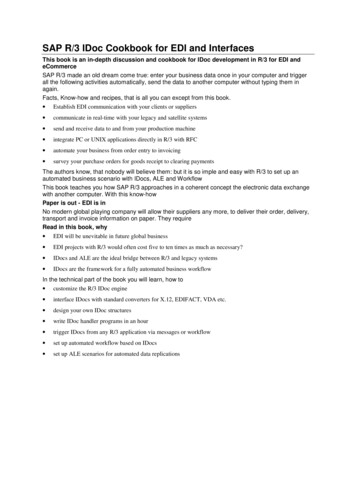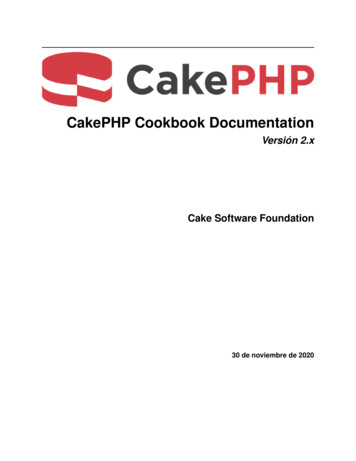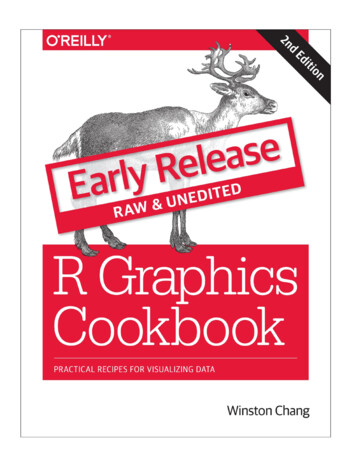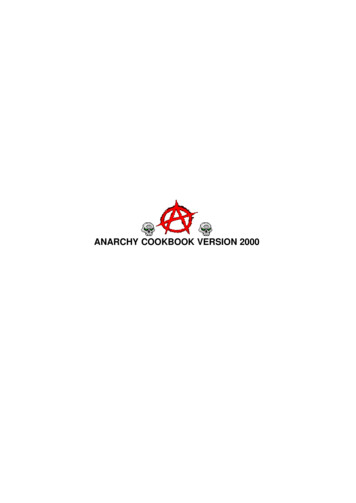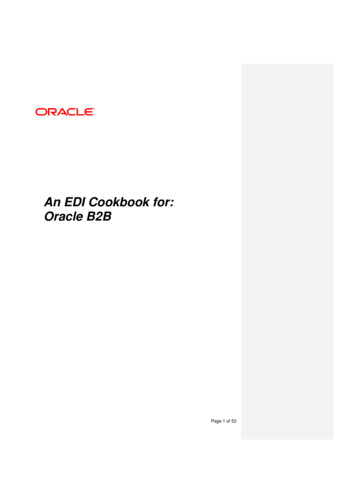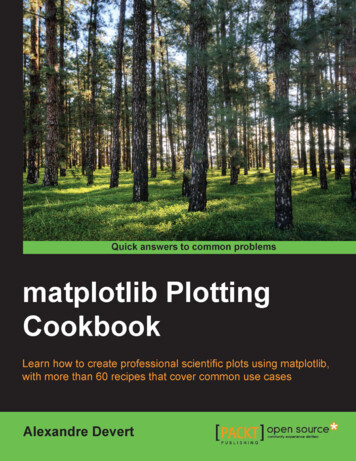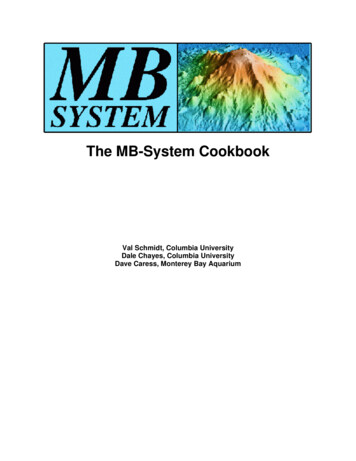
Transcription
The MB-System CookbookVal Schmidt, Columbia UniversityDale Chayes, Columbia UniversityDave Caress, Monterey Bay Aquarium
The MB-System Cookbookby Val Schmidt, Dale Chayes, and Dave Caress
Table of ContentsVersion . viii1. Introduction . 11.1. What Is This Document About? . 11.2. How Do I Get The Most Current Version? . 11.3. What is MB-System . 11.4. What Kind of Data Sets Can MB-System be Used On? . 11.5. Important Notes Regarding the Data Used in the MB-System Cookbook . 22. Multibeam Sonar Basics . 42.1. How Sound Travels Through Water . 42.1.1. Speed of Sound . 42.1.2. The Effects of Sound Speed Errors . 52.1.3. Spreading Loss . 102.1.4. Absorption . 102.1.5. Reverberation . 102.2. How Sound Interacts with the Sea Floor . 112.3. Acoustic Interference . 112.3.1. Radiated Noise or Self Noise . 112.3.2. Flow Noise . 122.3.3. Bubble Sweep Down . 122.3.4. Cross Talk . 122.4. Signal to Noise Ratio . 122.5. Swath Mapping Sonar Systems . 132.5.1. Multibeam Echo Sounders MBES . 132.5.2. Sidescan Swath Bathymetric Sonars SSBS . 133. Surveying Your Survey with MB-System . 143.1. Managing Your Data With mbdatalist . 143.2. Plotting Data . 163.3. Extracting Statistics . 254. Processing Multibeam Data with MB-System . 284.1. Overview . 284.1.1. Many Types of Sonar . 284.1.2. Strategy . 284.2. Identifying the MB-System Data Format . 294.3. Format Conversion . 304.3.1. Background . 314.3.2. SeaBeam 2100 . 314.3.3. Converting Your Data . 314.4. Survey and Organize the Data . 324.4.1. Integrating Your Data into a Larger Set . 334.4.2. Organize The Data Set Internally . 394.4.3. Ancillary Files . 394.4.4. Surveying your Survey - Revisited . 414.5. Determine Roll and Pitch Bias . 474.5.1. Roll Bias . 474.5.2. Pitch Bias . 574.6. Determine Correct SSP's . 574.6.1. Variations in Sound Speed and Your Data . 574.7. Smooth The Navigation Data . 654.7.1. MBnavedit . 654.8. Flag Erroneous Bathymetry Data . 814.8.1. Automated Flagging of Bathymetry . 824.8.2. Interactive Flagging of Bathymetry . 874.9. Determine Amplitude and Grazing Angle Functions for Side Scan . 97iv
The MB-System Cookbook4.10. The Final Step: Reprocessing the Bathymetry and Sidescan . 974.10.1. Mbset . 984.10.2. The Parameter File . 994.10.3. Mbprocess . 1075. Advanced Sonar Data Statistics . 1085.1. Advanced Statistics with mbinfo . 1085.2. Advanced Statistics with mblist . 1095.3. Advanced Statistics with mbgrid . 112A. Acknowledgments . 121B. MB-System Command Reference . 122C. Installing MB-System . 130C.1. Overview . 130C.2. Downloading MB-System . 130C.3. Installing GMT and netCDF . 130C.4. Creating a Directory Structure for MB-System . 131C.5. Editing "install makefiles" . 132C.6. Run install makefiles and Compile MB-System . 133D. Other Useful Tools . 136E. References . 137E.1. Acoustic References . 137E.2. Sonar References . 139F. History of MB-System . 141G. Shipboard Multi-Beam Sonar Installations . 142v
List of Figures2.1. Typical SSP . 52.2. Diagram of Planar Soundwaves Orthogonally Incident on a Linear Hydrophone Array. . 52.3. Diagram of Beam Forming Performed by A Linear Array . 62.4. Snell's Law . 83.1. Survey Navigation Plot . 173.2. Color Bathymetry Plot . 183.3. Color Bathymetry Plot with Contours . 203.4. High Intensity Color Bathymetry Plot with Contours . 213.5. Shaded Relief Color Bathymetry Plot . 233.6. Sidescan Plot . 244.1. Lo'ihi Archive Data Structure . 334.2. Lo'ihi Survey Navigation Data . 414.3. Lo'ihi Survey Navigation Plot . 434.4. Lo'ihi Survey Contour Plot . 444.5. Plot of First Data Leg for Roll Bias Calculation . 494.6. Plot of Second Data Leg for Roll Bias Calculation . 504.7. mbedit Screen Shot . 524.8. Plot of compositefirsttrackp.mb183 . 534.9. Plot of compositesecondtrackp.mb183 . 544.10. MB-VelocityTool . 614.11. MB-VelocityTool . 624.12. MB-VelocityTool with SSP's Loaded . 624.13. MB-VelocityTool with Plot Scaling Dialog . 634.14. MB-VelocityTool with Sonar Data Loaded . 634.15. MB-VelocityTool with Edited Profile . 644.16. MBnavedit . 674.17. MBnavedit . 684.18. MBnavedit Time Interval and Longitude Plots . 694.19. MBnavedit Latitude and Speed Plots . 694.20. MBnavedit Heading and Sonar Depth Plots . 704.21. MBnavedit Towed Sonar Time Difference and Longitude Plots . 724.22. MBnavedit Towed Sonar Latitude and Speed Plots . 734.23. MBnavedit Towed Sonar Speed Plot . 734.24. MBnavedit Towed Sonar Heading and Depth Plots . 744.25. MBnavedit Towed Sonar Heading and Depth Plots with "Made-Good" plots Removed . 754.26. Speed and Heading Plots Zoomed . 764.27. MBnavedit Heading and Sonar Depth Plots . 774.28. Interpolated Points . 784.29. Nav Modeling Window . 794.30. Dead Reckoning Position Plots . 804.31. Sumer Loihi Unedited Data . 834.32. Sumer Loihi Data with Outer Beams Flagged from MBclean . 844.33. Sumner Loihi Data with Outer Beams and Slope Greater than 1 Flagged from MBclean . 854.34. Sumner Loihi Data with Slope Greater than 1 Flagged and the Loss of Good Data . 864.35. MBedit GUI . 884.36. MBedit Open Sonar Swath File Dialog Box . 884.37. MBedit With Sonar Data Loaded . 894.38. MBedit With Display Adjustments . 914.39. MBedit Bathymetry Filters . 914.40. MBedit Bathymetry . 924.41. MBedit Filter by Beam Number . 934.42. MBedit Filter Results . 944.43. Unedited Data for Demonstration . 95vi
The MB-System Cookbook4.44. Interactive Editing Results . 965.1. Flat Bottom - STDEV vs Beam Number . 1095.2. Nadir Beam Depth Plot . 1105.3. Ping Interval vs. Bottom Depth . 1115.4. R/V Ewing Survey: Gridded Data . 1135.5. R/V Ewing Survey: Data Density Plot . 1145.6. R/V Ewing Survey: Gridded Standard Deviation . 1165.7. R/V Ewing Survey: Gridded Standard Deviation With New Color Map . 118vii
VersionVersion Information Id: mbcookbook.xml,v 1.12 2004/01/15 18:13:24 vschmidt Exp ---PRERELEASE--This is a working document in the Prerelease state. It is not particularly meaningful to maintain version history until an initial version is released. At that point a formal version history will be included and thesewords will be removed.viii
Chapter 1. Introduction1.1. What Is This Document About?This document provides detailed examples about how to process swath mapping data using the MB-System opensource software package. In addition to step-by-step instructions and explanations, code (scripts), data files and processed results are provided for each example. The examples use real data files, with typical data irregularities.There are a myriad of data collection systems supported by MB-System . What is more, MB-System supportsmany of the data format variations that have evolved as commercial vendors and academic designers have madechanges over the years. The MB-System designers have continually attempted to accommodate these changes andthe mbs; Cookbook is an attempt to document when data formats require special techniques in the processing.1.2. How Do I Get The Most Current Version?The most up to date version of this document can be obtained from the MB-System web page .intro.htmlwhere it can be found in both Portable Document Format (PDF) and Hypertext Markup Language (HTML). Alternatively, it can be downloaded via anonymous ftp from the Lamont-Doherty Earth Observatory at:ftp.ldeo.columbia.edu1.3. What is MB-System MB-System is a collection tools used to process research grade swath mapping sonar data in more than fourdozen formats from sonar equipment manufactured and operated around the world. MB-System is typically usedin conjunction with the Generic Mapping Tools (GMT) created by Paul Wessel of the University of Hawaii andWalter Smith of Lamont Doherty Earth Observatory. GMT is a powerful set of processes used to manipulate dataand to create Encapsulated Post Script maps and charts.1.4. What Kind of Data Sets Can MB-System beUsed On?MB-System rides atop a library of functions for reading and writing swath mapping sonar data files calledMBIO,(Multi Beam Input-Output).While largely unseen by the user, MBIO is where the rubber meets the road.MBIO takes into account multitudes of details, including existence of side scan or and or amplitude data, interpolation of navigation to ping times, geometry of specific sonar models, and of course the various data formats themselves. While MBIO does not support every possible data type, it has grown to accommodate the bulk of the sonardata formats common the the multibeam community. Indeed, considerable development is ongoing to support evergreater variations in sonar data formats, created both by commercial vendors and research institutions.In addition to the native data formats, MBIO defines many MB-System -only data formats. These have been created out of necessity when vendor native formats fail to accommodate the needs required of sonar processing, or aretoo unwieldy to store. For example, some Simrad sonars have traditionally stored navigation information separatefrom the bathymetry information, requiring interpolation of navigation to ping times each time the data is read.MBIO defines a data format stores the bathymetry and the interpolated navigation in a single composite file. Similarly, native Hydrosweep DS-2 data contain no less than 9 separate data files with multitudes of ancillary informationregarding the sonar's settings, but far more information than the sonar data itself. In this case, MBIO defines an alternate format that condenses the necessary navigation, bathymetry and sidescan information into a single, more1
Introductionmanageable and considerably smaller file. Many research institutions have found the MB-System formats preferable to the native sonar formats and perform a real time conversion of sonar data for their users.Stating which sonar and sonar formats are supported by MB-System is something of a moving target, however asof the time of this writing the following sonars were supported: SeaBeam "classic" 16 beam multibeam sonar Hydrosweep DS 59 beam multibeam sonar Hydrosweep MD 40 beam mid-depth multibeam sonar SeaBeam 2000 multibeam sonar SeaBeam 2112, 2120, and 2130 multibeam sonars Simrad EM12, EM121, EM950, and EM1000 multibeam sonars Simrad EM120, EM300, EM1002, and EM3000 multibeam sonars Hawaii MR-1 shallow tow interferometric sonar ELAC Bottomchart 1180 and 1050 multibeam sonars ELAC/SeaBeam Bottomchart Mk2 1180 and 1050 multibeam sonars Reson Seabat 9001/9002 multibeam sonars Reson Seabat 8101 multibeam sonars Simrad/Mesotech SM2000 multibeam sonars WHOI DSL AMS-120 deep tow interferometric sonar AMS-60 interferometric sonar1.5. Important Notes Regarding the Data Used in theMB-System CookbookIn an effort to demonstrate MB-System in as realistic manner as possible we have provided several real datasetsas examples.The standard MB-System distribution comes with an archive of example data sets and scripts generated usingMB-System (MB-SystemExamples.X.Y.Z.tar.Z). While these are not referenced directly within the Cookbook,they can be helpful examples and since their size is small they have been retained. When uncompressed and unarchived, the resulting directory tree will resemble the lines below.[vschmidt@val-LDEO mbexamples] lsdata mbbath mbgrid mbinfo mblist mbm plot README xbtThe /data directory contains several sample data files used in these examples. The other directories containscripts that briefly demonstrate the use of several of the tools in MB-System .For the purposes of the MB-System Cookbook, however these data sets were not sufficient to demonstrate the intricacies of various processing techniques, nor the art of managing a data set within a larger archive. Therefore, for2
Introductionthe purposes of the examples contained herein, you will find two separate collections of data that are freely download-able such that you may follow with each step we demonstrate.The first collection of data has been added to the mbexamples tar file. Within mbexamples/data/other data sets you will find a collection of directories each with smaller data sets used to illustratesome particular processing technique in MB-System . For example, discussions surround calculating roll bias andsound speed profiles utilize data sets in mbexamples/data/other data sets/rollbias andmbexamples/data/other data sets/ssp,respectfully.Adirectorycalled /mbexamples/cookbook examples has been created which will serve as a home directory for calculationsutilizing these data sets.To illustrate the processing and managing of data within a larger data archive we have provided a completely separate archive containing several data sets mapping the volcanic seamount Loihi off the southern coast of the big islandof Hawaii. Within the loihi data archive you will find four data sub directories, each with their own Loihi datasets. Extensive data processing has been conducted on the data sets with the exception of the MBARI1998EM300data. It has been purged of editing changes to better illustrate these examples; only the raw data files remain. Thisdirectory contains 140 MB of data - a more manageable amount to download than the entire 600 MB archive.Since some users may prefer to have the entire archive, as it affords the ability to see how to process and manage alarge archive with MB-System , we have provided tar files for both the full archive and just theMBARI1998EM300 data set.3
Chapter 2. Multibeam Sonar Basics2.1. How Sound Travels Through WaterThe basic measurement of most sonar systems is the time it takes a sound pressure wave, emitted from some source,to reach a reflector and return. The observed travel time is converted to distance using an estimate of the speed ofsound along the sound waves travel path. Estimating the speed of sound in water and the path a sound wave travelsis a complex topic that is really beyond the scope of this cookbook. However, understanding the basics provides invaluable insight into sonar operation and the processing of sonar data, and so we have included an abbreviated discussion here.2.1.1. Speed of SoundThe speed of sound in sea water is roughly 1500 meters/second. However the speed of sound can vary with changesin temperature, salinity and pressure. These variations can drastically change the way sound travels through water,as changes in sound speed between bodies of water, either vertically in the water column or horizontally across theocean, cause the trajectory of sound waves to bend. Therefore, it is imperative to understand the environmental conditions in which sonar data is taken.2.1.1.1. Affects of Temperature, Salinity and PressureThe speed of sound increases with increases in temperature, salinity and pressure. Although the relationship is muchmore complex, to a first approximation, the following tables provides constant coefficients of change in sound speedfor each of these parameters. Since changes in pressure in the sea typically result from changes in depth, values areprovided with respect to changes in depth. Change in Speed of Sound per Change in Degree C--- 3 meters/sec) Change in Speed of Sound per Change in ppt Salinity--- 1.2 meters/sec Change in Speed of Sound per Change in 30 Meters of Depth--- .5 meters/sec)1Temperature has the largest effect on the speed of sound in the open ocean. Temperature variations range from 28 Fnear the poles to 90 F or more at the Equator. Of course, relevant temperature differences with regard to multibeamsonar systems are the variations that occur over relatively short distances, in particular those that occur with depth.These are discussed further below.While the salinity of the world's oceans varies from roughly 32 to 38 ppt. These changes are gradual, such that within the range of a multibeam sonar, the impact on the speed of sound in the ocean is negligible. However near landmasses or bodies of sea ice, salinity values can change considerably and can have significant effects on the waysound travels through water.While the change in the speed of sound for a given depth change is small, in depth excursions where temperatureand salinity are relatively constant, pressure changes as a result of increasing depth becomes the dominating factor1Ulrich p 114.4
Multibeam Sonar Basicsin changes in the speed of sound.2.1.1.2. The Sound Speed ProfileThe composite effects of temperature, salinity and pressure are measured in a vertical column of water to providewhat is known as the "sound speed profile or SSP . A typical SSP is shown below:Figure 2.1. Typical SSPFrom the SSP above, one can see an iso-speed layer from the surface down to a few tens of meters due to mixing ofwater from wave action. This layer is called the "mixed surface layer" and is characterized by a flat or slightly negative (slanting down to the right) sound speed profile. The iso-speed layer is followed by a seasonal thermocline downto about 250 meters. Below, a larger main thermocline exists. These variations in the SSP are almost entirely due tochanges in temperature of the water. Below the main thermocline, the temperature becomes largely constant andchanges in pressure due to depth have the dominant effect on the SSP causing it to gradually increase.2.1.2. The Effects of Sound Speed ErrorsThere are two fundamental sound speed measurement inputs into multibeam sonar systems. These are 1) the speedof sound at the keel of the ship in the vicinity of the sonar array, and 2) the profile of sound speed changes verticallyin the water column. The former is used in the sonar's beam forming while the latter is used more directly in the thebathymetry calculations.2.1.2.1. Sound Speed Errors at the KeelIn an effort to understand the effect on sonar performance of an incorrect sound speed at the keel, we must discussthe process of beam forming. This discussion surrounds a single simplified beam forming method, of which thereare many. However it illustrates the effects well and the results can be applied to any sonar system.The sound speed at the keel of the ship, local to the array, affects the directivity of the beams produced by the sonar.The result is that the sonar is not exactly looking in the direction we expect, introducing considerable error.In multibe
The MB-System Cookbook Val Schmidt, Columbia University Dale Chayes, Columbia University Dave Caress, Monterey Bay Aquarium. . where it can be found in both Portable Document Format (PD

